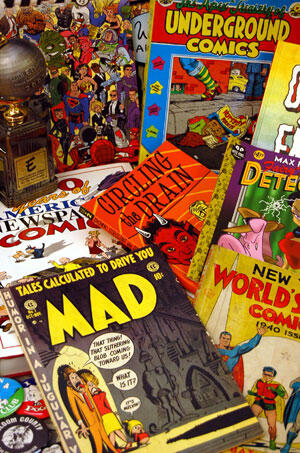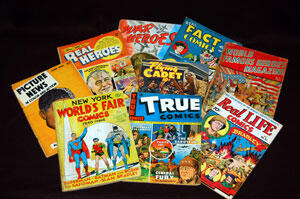June 12, 2006
Cabell Library Boasts Elite Comics Collection
Share this story

Tom De Haven was just 7 years old when he stumbled upon a Dick Tracy comic cover that featured, among other things, a woman with no eyeballs and a small child that was glowing in the dark. He was instantly snared. De Haven, now a professor of creative writing at Virginia Commonwealth University, soaked up the wild image and eventually started to compose a story in his head to explain the scene.
Comics have long been known for their capacity to seize on the curiosity of kids. However, in recent years, comic art and graphic novels also have become increasingly recognized as legitimate examples of art and literature, worthy of study and appreciation by “serious” adults. For instance, comic art and graphic novels now are studied in college classrooms and displayed in prestigious museums, and The New York Times reviews graphic novels in its influential pages.
“Comics are so fascinating as popular culture and they are real barometers and mirrors of political and social attitudes from our history, but they are also much more than that,” De Haven said.
At VCU, respect for the comic arts can be seen in the special collections department at the James Branch Cabell Library. The library hosts one of the largest collections of materials related to the comic arts in the United States, and the collection has been growing rapidly in recent years. The approximately 100,000 total items in the collection, which is open to the public, include graphic novels, fanzines, reference books, the original drawings and proofs for assorted newspaper strips, a broad variety of memorabilia and about 30,000 comic books.

Earlier this year, the library’s collection gained a valuable addition when the administrators of the Will Eisner Comic Industry Awards decided to entrust their archives to VCU. The Eisner Awards, the premier awards in the comics industry, are presented each summer at the massive Comic-Con International convention in San Diego. The archives donated to VCU will consist of all of the books and comics that have been nominated for Eisner Awards since 1992. Works nominated in the future also will be distributed to VCU.
University Librarian John Ulmschneider said the Eisner Award archives will not be relegated to a dark corner at the Cabell Library. They will be featured, enjoyed and studied.
“With one of the nation’s most prestigious art schools, the (Eisner) archives will provide crucial insights to students and faculty studying the vast diversity of craft in drawing, painting and visual storytelling,” Ulmschneider said. “And historians, artists and sociologists throughout the nation will benefit from easier access provided by the James Branch Cabell Library to such an important collection of comics and comic-related materials.”
VCU’s comic arts collection began in the 1970s, but it has been in more recent years that the collection has grown into an archive of national significance. Some of the featured donations to the collection are the papers and art of editorial cartoonists Fred Seibel and Bill Sykes; the personal library of Billy De Beck, the creator of the “Barney Google” strip; numerous resources from the collection of M. Thomas Inge, a professor at Randolph-Macon College; and a collection of rare 1940s true-life comics from William Blake, a professor emeritus of history at VCU.
Ulmschneider said word is beginning to spread among comics’ collectors about the attention the Cabell Library is paying to comic arts. He said the profile of the library’s collection has grown swiftly and donations have “started to snowball.” The collection encompasses a vast scope of materials, Ulmschneider said, though library officials’ aggressive goals for the collection include widening the collection’s breadth of materials even further.
“We hope to be a truly comprehensive holder of graphic expression and comic arts,” Ulmschneider said. “We would like to be the name in the Southeast in this area — the one that people think of.”
The strong interest in the comic arts at VCU is obvious and well-established, De Haven said. There are a number of VCU alumni who have made careers in comics — not to mention faculty members such as De Haven, Blake and Inge, a former VCU professor, who have studied various aspects of them. The response to De Haven’s course on graphic novels during the fall semester highlights the current student body’s regard for the topic. The 200-student quota was filled for the course and approximately 170 more students were turned away.
“For whatever reason, VCU has been a place that cartoonists and people interested in comics have been coming through for many years,” said De Haven, who has written about the comic arts in novels (e.g., the “Funny Papers” trilogy) and nonfiction work (pieces in The New York Times and Entertainment Weekly, among other publications).
And the connections to the comic arts at VCU extend beyond recent students and faculty. Jackie Estrada, administrator of the Eisner Awards, said the Cabell Library was a particularly appropriate home for the awards in light of the library’s namesake.
“I think it is quite fitting for the Eisner archives to go the Cabell Library, considering who James Branch Cabell was,” Estrada said in a press release. “His early 20th-century satirical fantasies were highly influential, not only on literary, science fiction and fantasy authors but also on comics creators, including (renowned comics writer) Neil Gaiman.”
Donors are increasingly viewing the Cabell Library as a suitable home for their treasured collections because of the obvious care the items receive. Cindy Jackson was hired seven years ago to handle the comics collection and to catalogue it. Jackson was a part-time student worker at the time of her hiring, but her role has grown in subsequent years and her position was made full-time in December.
Ulmschneider said it is unusual among university libraries to have a full-time staff member focused on a comics archive, but he said it demonstrates the library’s commitment to the collection. He said Jackson has labored hard to document items in the collection and to convey information about the archives to the public.
Jackson’s painstaking cataloguing of the items into a comprehensive database, including the posting of details about the items online, has brought a sense of accessibility and order that encourages comic readers and researchers, who appreciate being able to locate items quickly. The extent and detail of Jackson’s work has not been duplicated at many other large collections.
“We think our collection deserves this and that VCU deserves this,” Ulmschneider said. “Cindy has made tremendous progress.”
Jackson said visitors to the comics collection vary from 18-year-old students to 60-year-old enthusiasts, and she finds that rewarding their ardor often proves gratifying.
“It’s very cool when someone comes in looking for a specific title or an odd issue and I can just go grab it for them,” Jackson said. “I can see how much they appreciate that and how excited they get.”
Jackson said the VCU collection features endless gems for visitors to enjoy. Her favorites include MAD magazine No. 1, the copious Batman titles and the Classic Comics series, which condensed a number of famous novels into comic form.
“There’s just something fun about seeing Moby Dick presented in a comic book in 48 pages,” Jackson said.
The memorabilia in the comics collection elicit giddy reactions not only from visitors but from staff members at the library. Paraphernalia include such items as an Orphan Annie decoder pin from the 1930s, an Eisner Award (with its spinning globe), original set design paintings from the Batman television show of the 1960s and the door to De Beck’s studio apartment, featuring an original painting of Barney Google and Sparkplug — an item that causes De Haven to marvel.
“It’s absolutely amazing to have an item like that,” De Haven said. “That thing could be in the Smithsonian.”
However, De Haven emphasized that the historical pieces are only part of what makes the VCU collection special. It’s also the newer work, as epitomized by the Eisner archives, that provides VCU’s collection with a vibrancy to match the uniquely alive images found on a great comic’s pages.
“During the past two decades there have been some amazing, amazing American creators – some serious American creators – who have made this their field, and it’s critical that their work be kept alive,” De Haven said. “I think VCU is blessed to be part of that.”
Subscribe to VCU News
Subscribe to VCU News at newsletter.vcu.edu and receive a selection of stories, videos, photos, news clips and event listings in your inbox.







